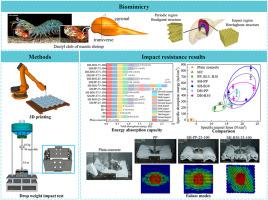Biomimetic 3D printed Herringbone-Bouligand SHCC for ultra-high impact resistance
IF 14.2
1区 材料科学
Q1 ENGINEERING, MULTIDISCIPLINARY
引用次数: 0
Abstract
Nature can create tough and lightweight materials under specific conditions. Learning from nature and developing novel biomimetic structures within synthetic materials is crucial for advancing impact-resistant materials. In this work, inspired by the dactyl club of mantis shrimp, we integrated Herringbone and Bouligand structures to produce 3D printed Strain-Hardening Cementitious Composites (SHCC) with ultra-high impact resistance. Through 3D concrete printing, SHCC filaments and fibers were arranged coaxially and form a Herringbone-Bouligand structure. The results indicated that the Herringbone-Bouligand structure significantly enhanced the impact resistance of SHCC. The Herringbone-Bouligand structure exhibited the highest specific absorption energy of 843.3 ± 45.19 mJ/cm3 and a specific impact force of 23.8 ± 1.17 N/cm3. Its specific absorption energy was 290.8 times greater than that of plain concrete (2.9 ± 0.08 mJ/cm3), while its specific impact force was 7.0 times higher than that of plain concrete (3.4 ± 0.05 N/cm3). The toughening mechanism was attributed to the sinusoidal arrangement of the SHCC filaments, which absorbed the impact force through spring deformation, and the Bouligand arrangement, which promoted crack twisting. This combination allowed the structure to better absorb and release energy. The Herringbone-Bouligand structure offers a promising solution for protective applications in harsh environments and provides valuable insights for developing impact-resistant, lightweight cementitious materials through biomimetic strategies.

仿生3D打印人字形- bouligand SHCC,超高抗冲击性
大自然可以在特定条件下创造出坚韧而轻便的材料。从自然中学习,在合成材料中开发新的仿生结构是推进抗冲击材料的关键。在这项工作中,我们受到螳螂虾的dactyl俱乐部的启发,将Herringbone和Bouligand结构结合在一起,生产出具有超高抗冲击性的3D打印应变硬化胶凝复合材料(SHCC)。通过3D混凝土打印,将SHCC细丝和纤维同轴排列,形成人字形-布利甘结构。结果表明,Herringbone-Bouligand结构显著提高了SHCC的抗冲击性。人字形-布利甘结构的比吸收能最高,为843.3±45.19 mJ/cm3,比冲击力为23.8±1.17 N/cm3。比吸收能是素混凝土的290.8倍(2.9±0.08 mJ/cm3),比冲击力是素混凝土的7.0倍(3.4±0.05 N/cm3)。SHCC细丝的增韧机制主要是通过弹簧变形吸收冲击力的正弦排列和促进裂纹扭转的Bouligand排列。这种组合使结构能够更好地吸收和释放能量。Herringbone-Bouligand结构为恶劣环境下的防护应用提供了一种很有前途的解决方案,并通过仿生策略为开发抗冲击、轻质胶结材料提供了宝贵的见解。
本文章由计算机程序翻译,如有差异,请以英文原文为准。
求助全文
约1分钟内获得全文
求助全文
来源期刊

Composites Part B: Engineering
工程技术-材料科学:复合
CiteScore
24.40
自引率
11.50%
发文量
784
审稿时长
21 days
期刊介绍:
Composites Part B: Engineering is a journal that publishes impactful research of high quality on composite materials. This research is supported by fundamental mechanics and materials science and engineering approaches. The targeted research can cover a wide range of length scales, ranging from nano to micro and meso, and even to the full product and structure level. The journal specifically focuses on engineering applications that involve high performance composites. These applications can range from low volume and high cost to high volume and low cost composite development.
The main goal of the journal is to provide a platform for the prompt publication of original and high quality research. The emphasis is on design, development, modeling, validation, and manufacturing of engineering details and concepts. The journal welcomes both basic research papers and proposals for review articles. Authors are encouraged to address challenges across various application areas. These areas include, but are not limited to, aerospace, automotive, and other surface transportation. The journal also covers energy-related applications, with a focus on renewable energy. Other application areas include infrastructure, off-shore and maritime projects, health care technology, and recreational products.
 求助内容:
求助内容: 应助结果提醒方式:
应助结果提醒方式:


